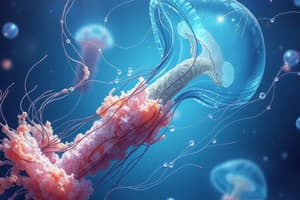Podcast
Questions and Answers
What are Cnidaria?
What are Cnidaria?
True jellyfish
What are the two forms of Cnidaria?
What are the two forms of Cnidaria?
Polyp and medusa
Describe the polyp form.
Describe the polyp form.
Tubular; mouth directed upward with feeding tentacles around it; small amount of mesoglea; sessile
Describe the medusa form.
Describe the medusa form.
Describe the means of locomotion for cnidaria.
Describe the means of locomotion for cnidaria.
How do jellyfish feed?
How do jellyfish feed?
Describe the structure of cnidocytes (stinging organelles).
Describe the structure of cnidocytes (stinging organelles).
Describe reproduction for Cnidaria.
Describe reproduction for Cnidaria.
Describe Class Hydrozoa.
Describe Class Hydrozoa.
Describe solitary hydras.
Describe solitary hydras.
Describe colonial hydras.
Describe colonial hydras.
Describe Class Scyphozoa.
Describe Class Scyphozoa.
Describe the life cycle of Scyphozoans.
Describe the life cycle of Scyphozoans.
Describe Class Cubozoa.
Describe Class Cubozoa.
Describe Class Anthozoa.
Describe Class Anthozoa.
Solitary anthozoans include ________________.
Solitary anthozoans include ________________.
Are most anthozoans colonial or solitary?
Are most anthozoans colonial or solitary?
How do corals obtain most of their energy?
How do corals obtain most of their energy?
Flashcards are hidden until you start studying
Study Notes
Overview of Phylum Cnidaria
- Cnidaria includes true jellyfish, characterized by their unique stinging cells called cnidocytes.
Forms of Cnidaria
- Two main forms exist: polyp (sessile) and medusa (free-swimming).
Polyp Form
- Tubular structure with an upward-facing mouth surrounded by feeding tentacles.
- Contains a small amount of mesoglea; primarily attached to a surface.
Medusa Form
- Umbrella-shaped body with a downward-facing mouth.
- Features multiple tentacles extending from the bell and contains a large amount of mesoglea.
- Propels by contracting its body weakly.
Locomotion
- Exhibits coordinated movement via a nerve net comprising both epidermis and gastrodermis.
Feeding Mechanism
- Jellyfish are carnivorous, utilizing tentacles to capture prey.
- Food particles enter and waste is expelled through the gastrovascular cavity.
- All internal processes, including gas exchange and excretion, occur via diffusion.
Cnidocytes Structure
- Cnidocil is equipped with a stinging organelle known as a nematocyst.
- Nematocyst contains a coiled thread; when activated, it releases the thread which can either ensnare prey or inject toxins.
Reproduction
- Cnidarians reproduce through external fertilization, involving both sexual and asexual methods.
Class Hydrozoa
- Life cycle alternates between polyp and medusa stages; can be solitary or colonial.
- Present in various marine habitats.
- Examples include Obelia and Man-Of-War.
Solitary Hydras
- Freshwater organisms that inhabit ponds and streams, typically found on vegetation.
- Structure includes a pedal disc, mouth, hypostome, and 6-10 tentacles.
- Simple reproductive cycle involves external fertilization with a capability for asexual reproduction through budding.
Colonial Hydras
- Comprise interconnected polyps with a chitin skeleton.
- Include feeding polyps (gastrozooids) and reproductive polyps (gonozooids).
Class Scyphozoa
- True jellyfish characterized by large medusae and extensive mesoglea.
- Lacks a velum; contains four gastric pouches lined with nematocysts connected to the gastrovascular system.
Life Cycle of Scyphozoans
- Free-swimming medusa releases eggs or sperm, which unite to form a planula.
- Planula anchors to a substrate and develops into a polyp, which eventually produces ephyra, later maturing into a medusa.
- Examples include cannonball jelly and sea nettle.
Class Cubozoa
- Known as box jellies; distinguished by their square shape when viewed from above.
- Features four groups of tentacles and advanced vision.
- Noted for their potent sting.
Class Anthozoa
- Exclusively marine, lacking a medusa stage.
- Possesses siphonoglyph, aiding in water circulation and food intake.
- Characterized by a well-developed pharynx and large gastrovascular cavity.
Solitary and Colonial Anthozoans
- Solitary representatives include sea anemones.
- Most anthozoans are found in colonial forms.
Coral Energy Acquisition
- Corals derive the majority of their energy from symbiotic microscopic photosynthetic algae living within their cells.
Studying That Suits You
Use AI to generate personalized quizzes and flashcards to suit your learning preferences.



